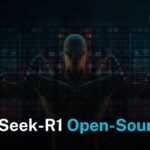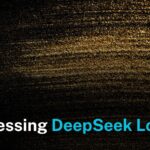DeepSeek-R1 AI Model emerges as a lighthouse of efficiency, precision, and accessibility. This open-source marvel challenges the old-world AI aristocracy, proving that smaller, well-trained models can stand tall against monolithic architectures. With efficient knowledge distillation, hybrid fine-tuning techniques, and an open-source revolution, DeepSeek-R1 reshapes the way AI is built, refined, and deployed
Introduction: A Defining Moment in Open-Source AI
The AI landscape is undergoing a significant transformation with DeepSeek-R1, an open-source AI model that challenges the dominance of proprietary giants like OpenAI, Anthropic, and Google DeepMind. While mainstream discussions focus on its $5.5 million training cost, the real breakthroughs lie elsewhere:
Three Game-Changing Innovations:
1️⃣ Efficient Knowledge Transfer via Model Distillation – DeepSeek-R1 demonstrates that smaller, distilled models can match state-of-the-art (SOTA) models using minimal fine-tuning data and lower compute requirements.
2️⃣ Hybrid AI Training Approach (Fine-Tuning + Reinforcement Learning) – Instead of relying solely on Reinforcement Learning (RL), DeepSeek-R1 leverages a structured fine-tuning process before RL, drastically improving model efficiency and accuracy.
3️⃣ Open-Source AI Disrupting Proprietary Models – With its MIT open-source license, DeepSeek-R1 erodes the competitive advantage of closed AI models, allowing startups, researchers, and enterprises to leverage cutting-edge AI without licensing restrictions.
This article debunks the myths surrounding DeepSeek-R1, explores its efficiency-driven techniques, and provides a developer guide on getting started with this groundbreaking model.
1. Efficient Knowledge Transfer Through Model Distillation
How Model Distillation Works
Model distillation is a technique that transfers knowledge from a large, computationally expensive AI model (teacher) to a smaller, more efficient model (student). The benefits include:
- Smaller, computationally efficient models that retain high accuracy.
- Lower training and inference costs, reducing reliance on high-end GPUs.
- Elimination of billion-dollar infrastructure dependencies required for training massive models.
DeepSeek-R1’s Breakthrough in Distillation
Chris Hay, a Distinguished Engineer, demonstrated that using only ~1000 lines of fine-tuning data, he was able to achieve GPT-4 level math performance on a 1.5B parameter model—running entirely on a laptop.
📌 Key Takeaways from DeepSeek-R1’s Distillation Approach:
- ✅ Fine-tuning even small models can yield SOTA performance.
- ✅ High-cost AI training is no longer a strict requirement.
- ✅ Distilled models are highly efficient for real-world applications.
Benchmarking DeepSeek-R1 Against Other AI Models
| Model | Size (Billion Params) | Hardware Required | Fine-Tuning Needed? | Performance on Benchmarks |
|---|---|---|---|---|
| GPT-4 | Undisclosed (~1 Trillion?) | High-end GPUs | Yes | SOTA |
| Claude 2 | ~100-200 (Est.) | High-end GPUs | Yes | High |
| DeepSeek-R1 | 67B (MoE) | Moderate GPUs | Yes | Competitive |
| Llama 2 7B | 7B | Consumer GPUs | Yes | Moderate |
📌 Clarification: The GPT-4 parameter count is speculative as OpenAI has not publicly disclosed the actual number.
🔎 Key Lesson:
DeepSeek-R1 proves that state-of-the-art performance is achievable without scaling up models to trillion-parameter levels.
2. Hybrid AI Training: Fine-Tuning + RL > Pure RL
One of DeepSeek-R1’s most misunderstood aspects is its training methodology. Contrary to popular belief, it does not rely solely on Reinforcement Learning (RL). Instead, it follows a hybrid approach, which significantly improves efficiency.
How This Hybrid Approach Works
🚀 Step 1: Structured Fine-Tuning – Before applying RL, the model undergoes fine-tuning using accurate Chain-of-Thought (CoT) reasoning.
🚀 Step 2: Reinforcement Learning Optimization – RL is used only after the model has been structured with fine-tuning, optimizing responses further.
Why DeepSeek-R1’s Hybrid Training Outperforms RL-Only Models
- DeepSeek-R1-Zero (trained with RL only) performed worse on reasoning tasks and struggled with hallucinations.
- DeepSeek-R1 (Fine-Tuning + RL Hybrid) delivered superior accuracy across multiple benchmarks.
📌 Key Takeaway: Fine-tuning followed by RL produces significantly more accurate AI models.
3. Open-Source AI Disrupting Proprietary Models
DeepSeek-R1’s MIT open-source license allows anyone to:
- Train and deploy AI models without licensing fees.
- Fine-tune AI for specific tasks at minimal cost.
- Contribute to AI research without restrictions.
Potential Risks of Open-Source AI
- Misuse Risks – Open-source AI can be exploited for deepfakes, misinformation, and security threats.
- Lack of Accountability – Unlike corporate AI models, no single entity governs DeepSeek-R1’s usage.
- Security Vulnerabilities – Open models can lack built-in safeguards that proprietary AI companies enforce.
📌 Key Takeaway: Open-source AI accelerates innovation but introduces serious ethical challenges.
4. Architecture Innovation: From Mixture of Experts (MoE) to Dense Networks
DeepSeek-R1’s transition from Mixture of Experts (MoE) to a fully dense model represents a major architectural shift.
Why This Matters
- ✅ MoE models are powerful but computationally expensive.
- ✅ DeepSeek-R1 optimizes MoE models into a dense network without performance loss.
- ✅ Increased token throughput reduces computation costs.
📌 Key Takeaway: DeepSeek-R1’s efficiency proves that smaller models, when trained effectively, can match much larger ones.
5. Getting Started with DeepSeek-R1: A Developer’s Guide
For those interested in experimenting with DeepSeek-R1, here’s a basic guide:
1: Setup Requirements
🔹 Hardware: Minimum NVIDIA A100 or RTX 3090 GPU recommended.
🔹 Dependencies: Install transformers, torch, and datasets.
2: Install DeepSeek-R1
pip install deepseek-transformers torch datasets3: Load the Model
from transformers import AutoModelForCausalLM, AutoTokenizer
model_name = "deepseek-ai/deepseek-r1"
tokenizer = AutoTokenizer.from_pretrained(model_name)
model = AutoModelForCausalLM.from_pretrained(model_name)4: Running Inference
input_text = "What are the core innovations of DeepSeek-R1?"
inputs = tokenizer(input_text, return_tensors="pt")
output = model.generate(**inputs)
print(tokenizer.decode(output[0], skip_special_tokens=True))📌 Key Takeaway: DeepSeek-R1 is easy to integrate and experiment with using open-source libraries.
Conclusion: A New Era of AI Innovation
DeepSeek-R1 proves that AI development no longer requires trillion-parameter models. The combination of distillation, fine-tuning, RL, and open-source distribution makes it a powerful alternative to proprietary AI.
- ✅ Distilled models can match SOTA performance.
- ✅ Fine-Tuning + RL outperforms RL-only approaches.
- ✅ Open-source AI is democratizing innovation.
🚀 Final Thought:
DeepSeek-R1 is not just an AI model—it’s a glimpse into the future of AI development: efficient, open, and accessible.
Reference
For those who want to explore DeepSeek-R1 further, here are some official resources, research papers, and discussions:
🔹 DeepSeek-R1 Official Repository – GitHub: deepseek-ai/deepseek-r1
🔹 Hugging Face Model Page – DeepSeek-R1 on Hugging Face
🔹 Reinforcement Learning in AI – A Survey of RL in NLP (MIT Press)
🔹 Understanding Model Distillation – Google Research on Knowledge Distillation





Leave a Reply